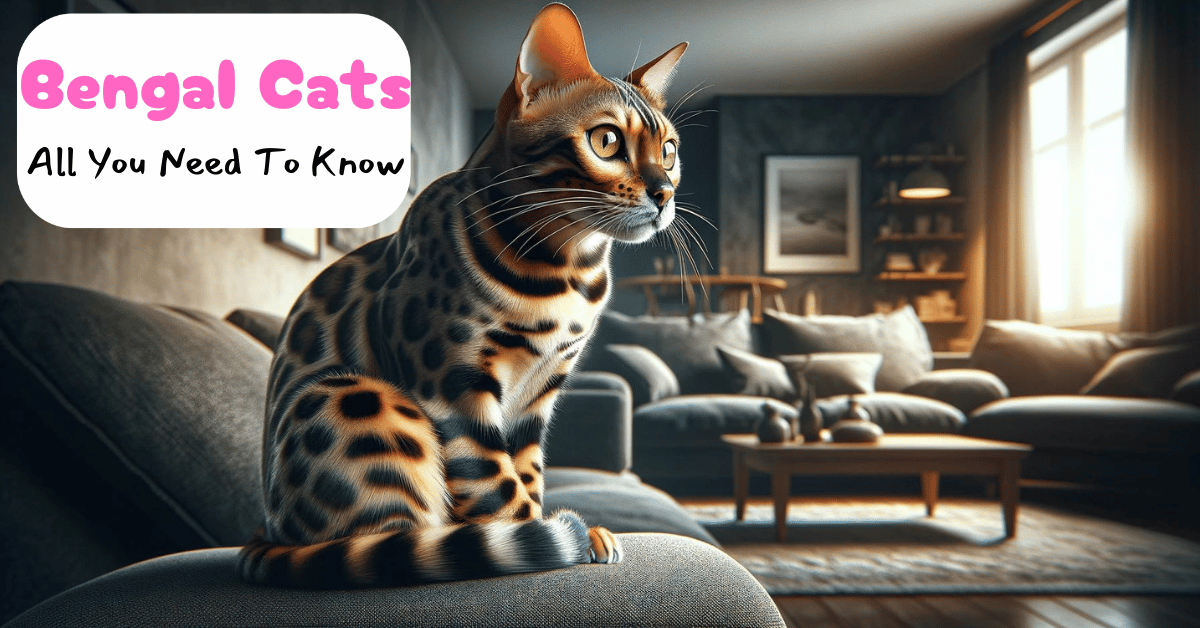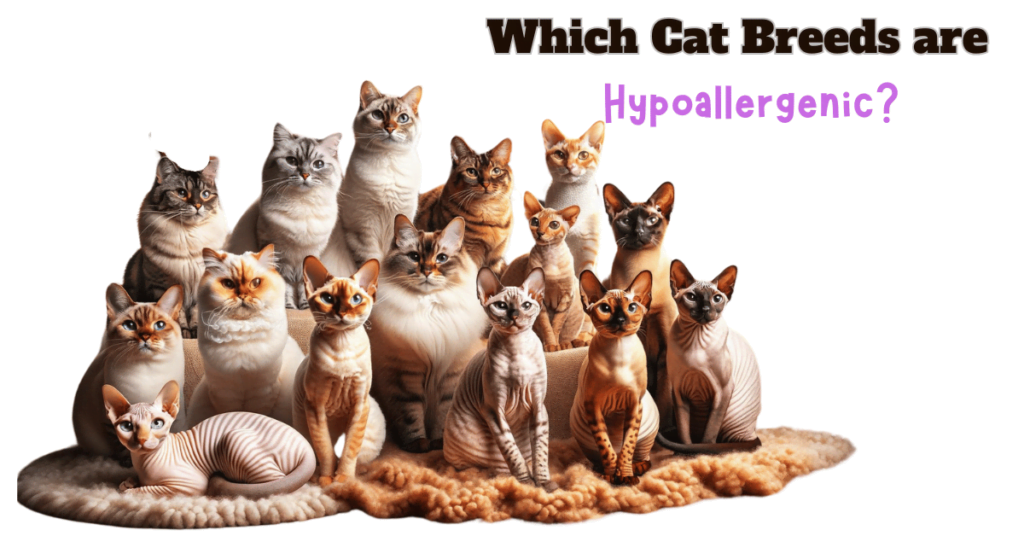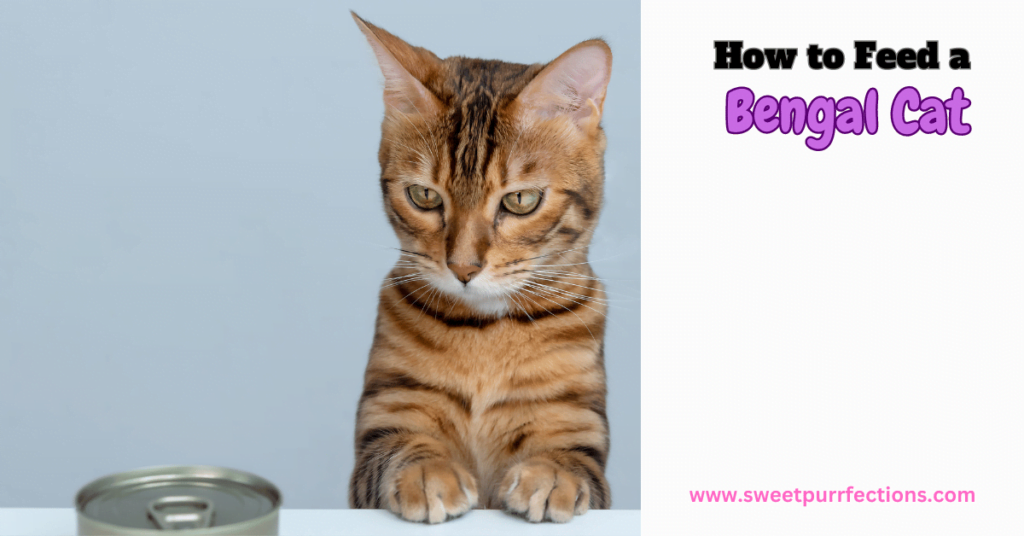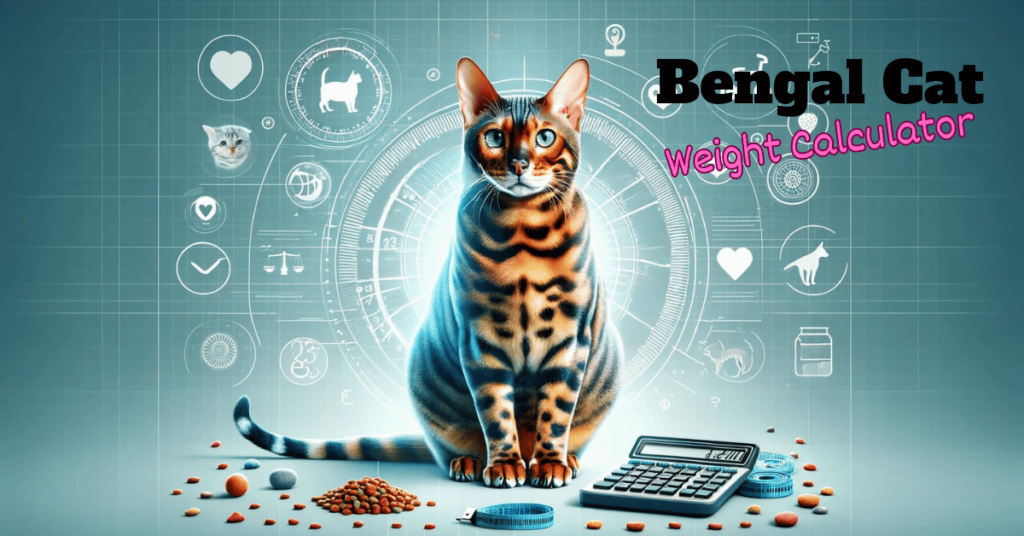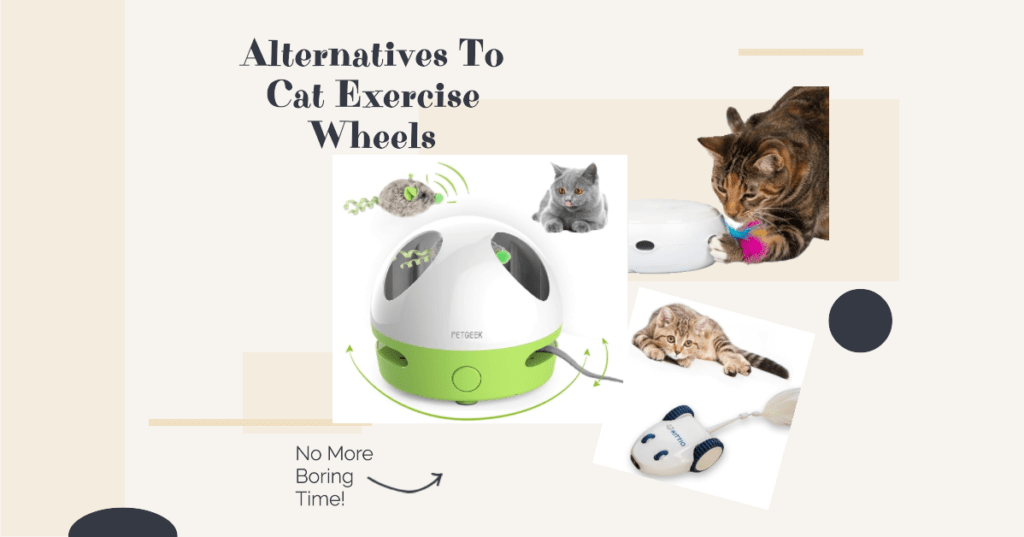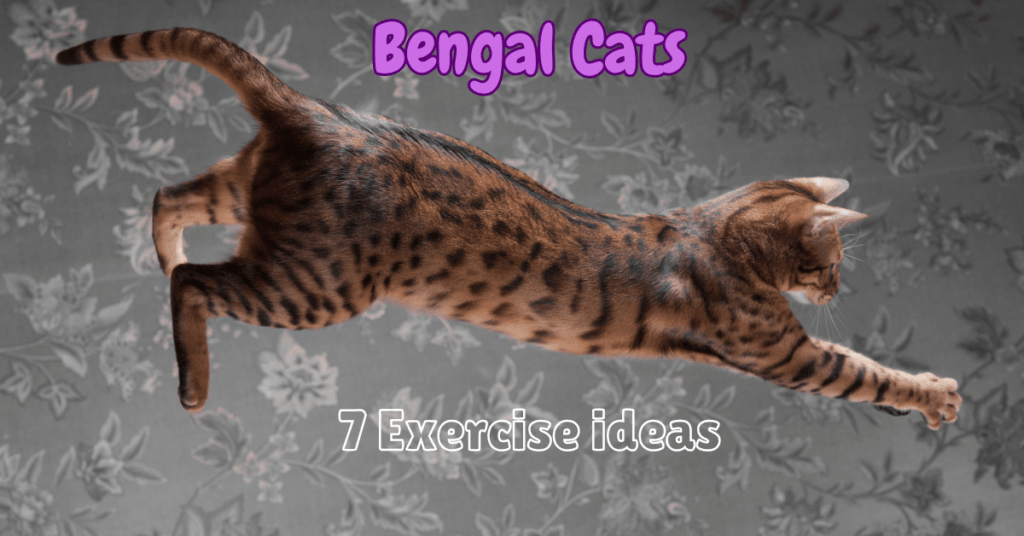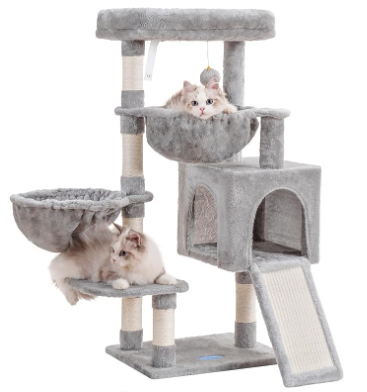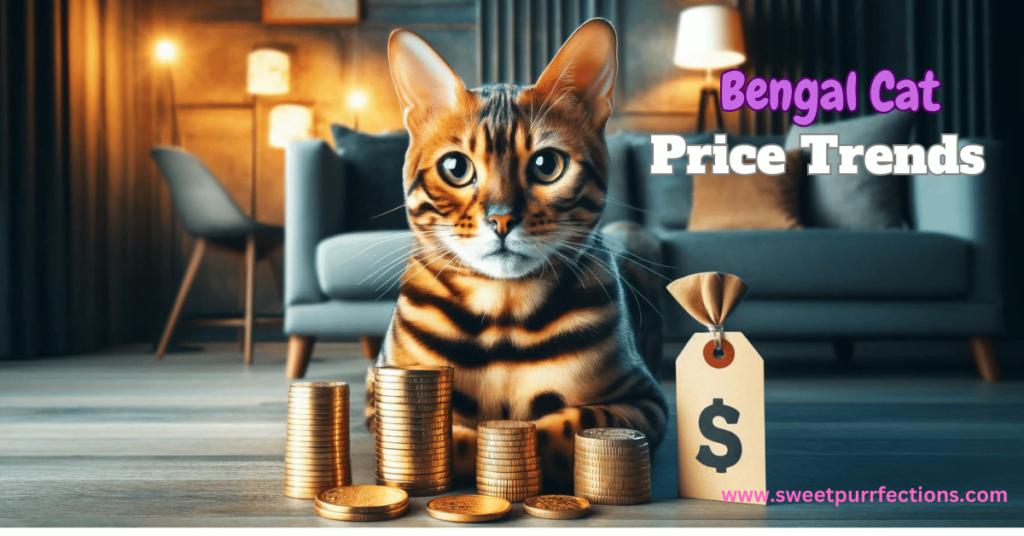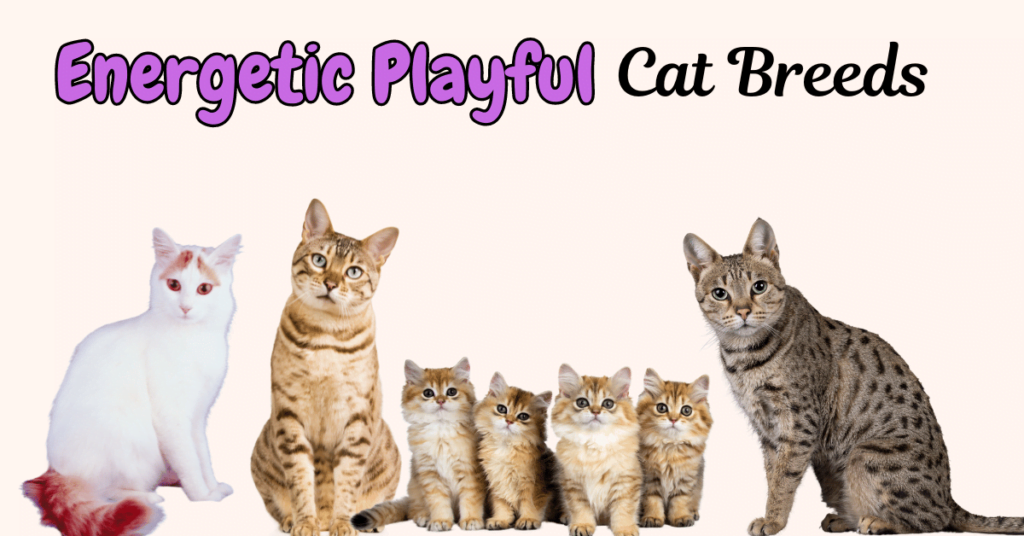This post contains affiliate links and I will be compensated if you make a purchase after clicking on my links.
Introduction to the Bengal Cat Breed
Bengal cats, known for their wild appearance and dynamic personalities, offer a glimpse into the animal kingdom from the comfort of your living room. As a large cat breed, they stand out not just for their size but for their striking looks and energetic nature. But what exactly makes Bengal cats so special, and how did they leap from the wild into our homes?
Bengal Cats have an intriguing backstory that started in the early 1900s. But, it was in the 1970s when things really got interesting, thanks to a visionary named Jean Sugden Mill. She had a dream: to combine the wild beauty of the Asian leopard cat (Felis bengalensis) with the friendly nature of domestic cats.
And voilà, the Bengal breed was born, setting the stage for these mini leopards to leap into our hearts and homes.
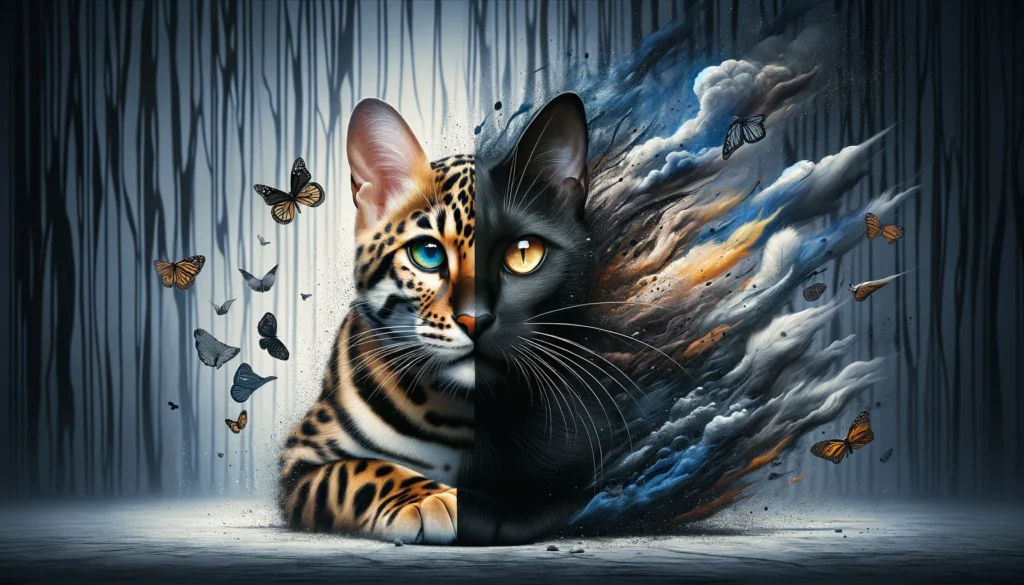
By the 1990s, Bengal Cats had established themselves as a domestic favorite, celebrated not only for their mesmerizing looks but also for their spirited and affectionate nature. With muscular bodies, long hind legs, and sleek coats adorned with distinctive markings, Bengals are the embodiment of miniature leopards.
Bengal Cats Key Characteristics
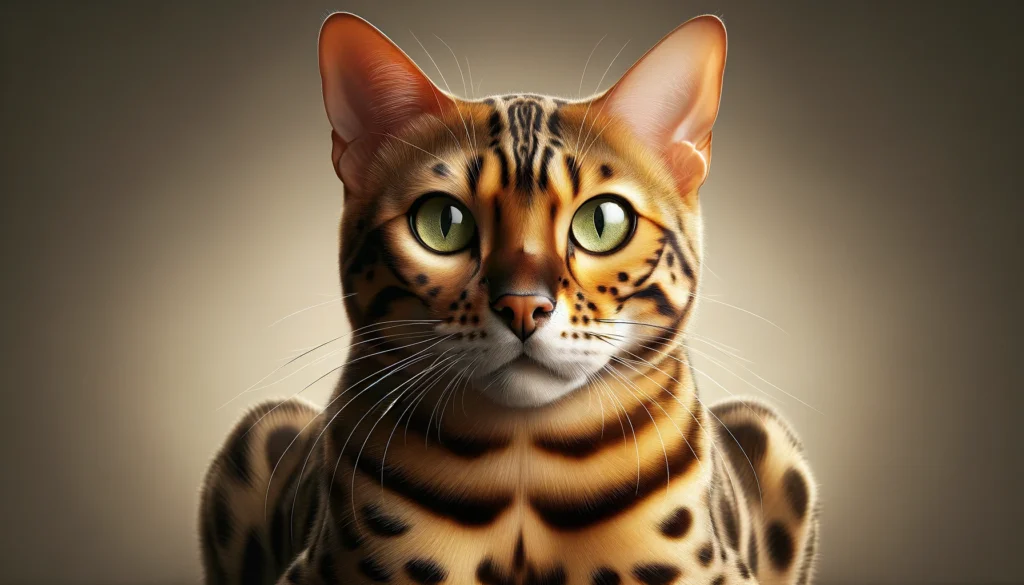
- Distinctive Coat Patterns: Spotted or marbled patterns that mirror the wild appearance of their leopard ancestors.
- Vibrant Coat Colors: A wide range of colors from golden, rust, and brown to silver and charcoal.
- Glittering Fur: Unique shimmering effect on their fur, making it look as if it’s sprinkled with glitter.
- Muscular and Athletic Build: Sleek, powerful physique showcasing their strength and agility.
- Striking Eyes: Large, oval or almond-shaped eyes in shades of green, gold, or blue.
- Small Rounded Ears: With wide bases, contributing to their wild look.
- Prominent Whisker Pads: Giving their face a distinctive, expressive appearance.
Understanding The Bengal Cat Breed: Temperament and Behavior
Bengal cats are not your typical lap cats; they’re adventurers at heart, always on the prowl for the next game or puzzle. Their loyalty is unmatched, often forming strong bonds with their human companions, yet they possess a fierce independence and a clear preference for exploring on their terms. While they might not be big on cuddling, they show their love in other unique ways.
Their bold and adventurous spirit means they might not be the best fit for everyone. For households looking for a more laid-back feline friend, the Bengal’s vivacity and need for stimulation could be overwhelming.
They’re best suited to those who can provide plenty of playtime, interaction, and enrichment activities. Their sociable nature means they generally get along well with children and other pets like dogs, especially when socialized from a young age.
However, their strong hunting instincts can sometimes be too much for smaller pets, who might be seen as prey. This is a key consideration for households with a diverse pet lineup, as there have been cases where under-stimulated or bored Bengals have shown aggression.
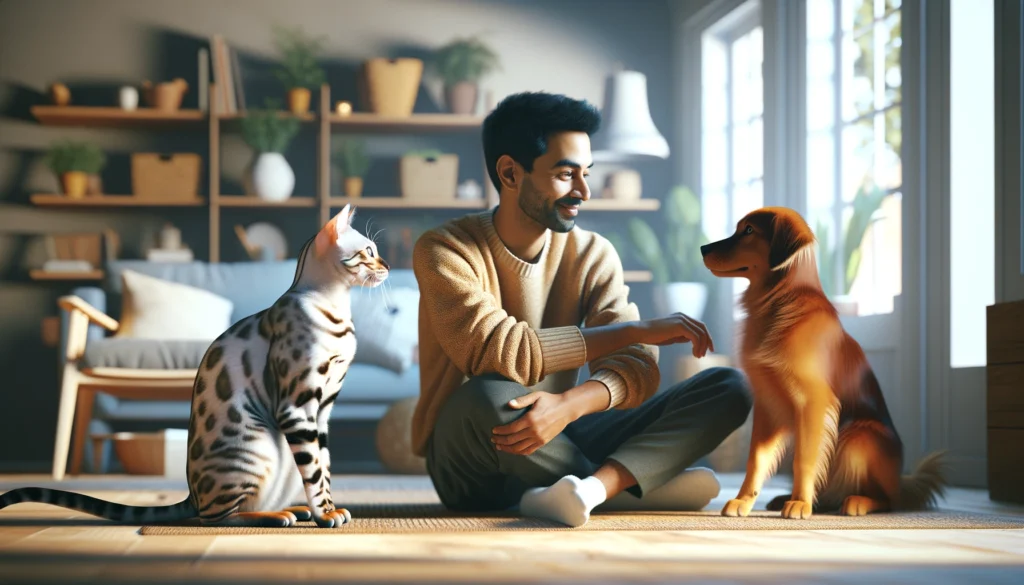
One of the most enchanting traits of the Bengal is their love for water, a rarity among felines. These cats may surprise you by joining for a splash in the bath, swimming poor or by showing a keen interest in running water, turning routine activities into playful moments.
The Iconic Look: Physical Characteristics of Bengal Cats
Bengal Cats boast muscular bodies built for the hunt, complete with long, springy hind legs that could easily make them the high jump champions of the cat world. Their sleek, velvety coats are a canvas for nature’s artistry, featuring patterns that range from the bold, dark marbling to the striking, spotted rosettes that mimic their wild ancestors.
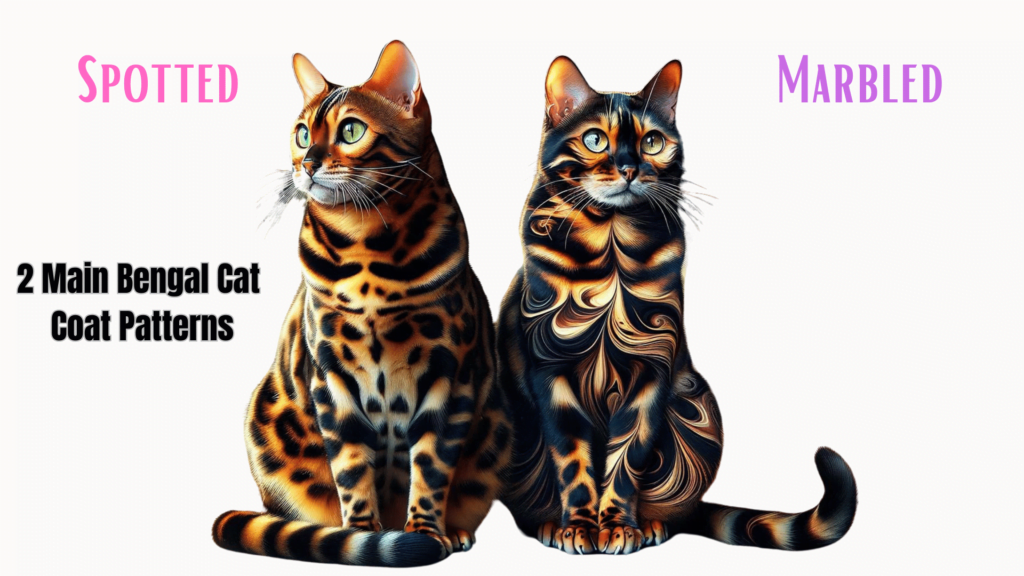
But it’s not just about the spots; the range of coat colors in Bengals is a spectrum of nature’s palette. From the rich, earthy tones of the brown Bengals to the ethereal beauty of the snow Bengals, each hue tells a story. And then there’s the silver, charcoal, blue, and even the mystical melanistic—a shadowy figure that looks like it’s stepped straight out of a moonlit tale.
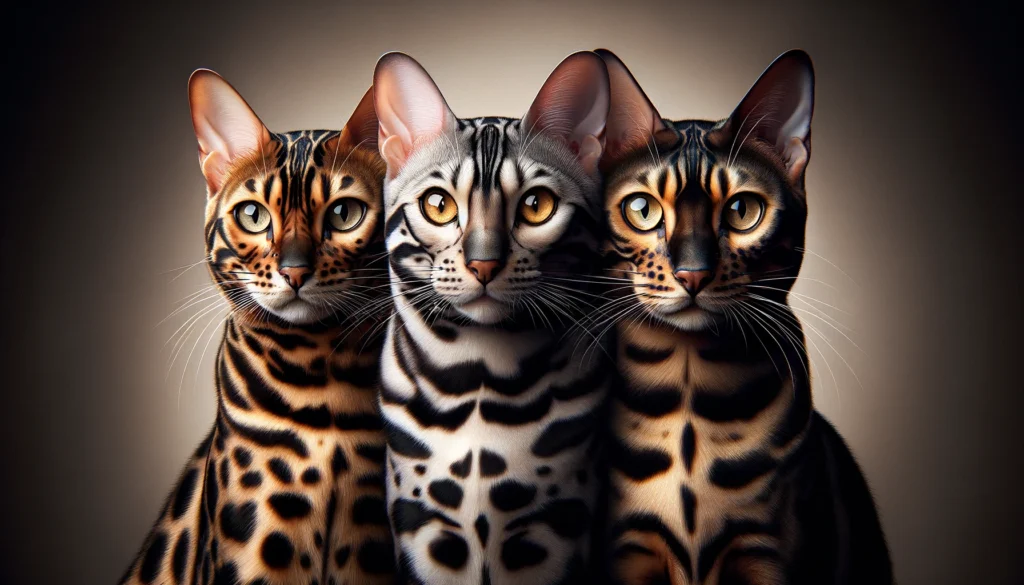
Don’t get lost in the coat patterns without noticing their ears—small, round-tipped, always alert, as if listening for the whispers of the wild. And the eyes! From the deepest hazel to the shimmering copper, each pair is a mesmerizing gem. Snow Bengals often boast stunning blue, blue-green, or aqua eyes, like pools of clear, tropical waters.
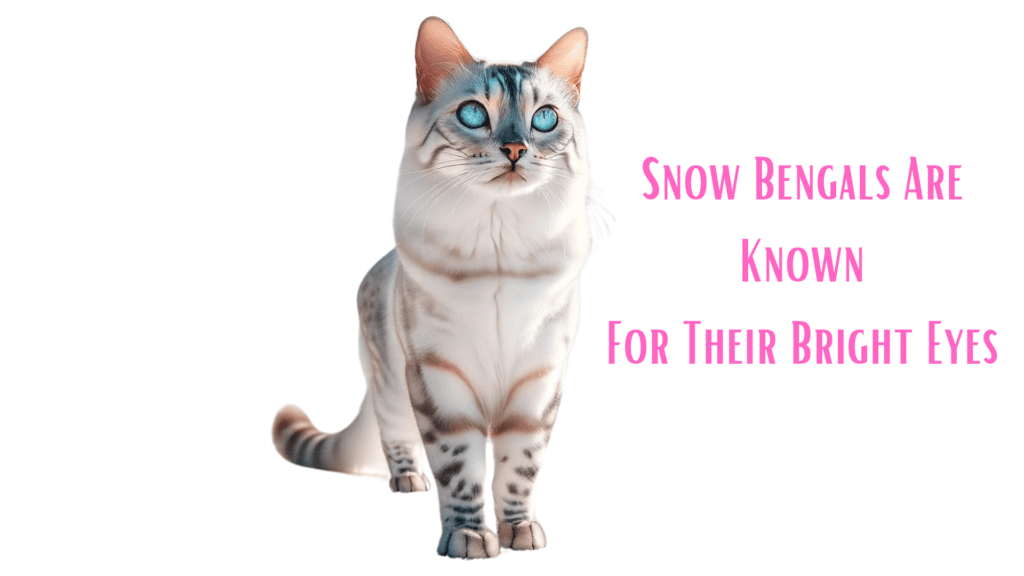
Perhaps the most magical feature is the glittery coat seen in some Bengals. This isn’t just your average cat shimmer; this is a coat kissed by stardust, thanks to translucent hair shafts that catch the light, making them look as if they’re sprinkled with glitter.
Note: One reason Bengal cats are semi-hypoallergenic is their unique coat. They need less grooming, which means their fur has less allergen-rich saliva.
Caring for Your Bengal Cat: Health and Nutrition
Health Conditions of Bengal Cats
While Bengals might look like they’ve just wandered out of a jungle, their health and nutrition needs are very much domestic. Like all breeds, they come with their own set of health considerations.
- Distal Neuropathy: This is a nerve condition that might make your Bengal cat move in unusual ways. They could seem weak or clumsy, which is actually due to the nerves not working properly.
- Feline Lower Urinary Tract Disorder (FLUTD): It’s a complex condition affecting their bladder and urethra, leading to discomfort and potential health concerns.
- Hip Dysplasia: Not just a challenge for the big dogs. Bengals can face this joint issue too, which might slow down their tree-climbing (or, more likely, couch-jumping) adventures.
- Hypertrophic Cardiomyopathy: A heart condition that’s as complex as it sounds. It means your Bengal’s heart might be working overtime, even when they’re just dreaming of their next hunt.
- Progressive Retinal Atrophy: This eye condition could lead to night vision not as sharp as their ancestors’, affecting their ability to spot a mouse (or a toy) in low light.
- Flat-Chested Kitten Syndrome: This syndrome affects kittens’ chest development, requiring a watchful eye and care.
Nutrition and Diet for Bengal Cats
These cats aren’t just any household pets; they are natural athletes, embodying grace and power in every leap and bound. When it comes to the type of food, Bengals benefit from a diet that mimics what they might eat in the wild. This means high-quality, meat-based foods are the order of the day.
Opt for a raw cat food diet or premium wet commercial food, with real meat as the primary ingredient—think duck, chicken, or rabbit. These protein-rich foods provide the amino acids essential for muscle development and overall health.
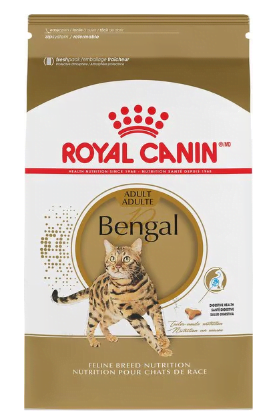
The Bengal Cat Breed Diet Essentials: Optimal Portion Sizes
The nutritional needs of Bengal cats, mirroring the precision of their wild ancestors, demand particular attention, especially regarding caloric intake. These requirements shift dramatically from their energetic kitten phase into the more measured pace of adulthood, molded by their activity levels and rate of growth.
It’s advised that Bengals consume about 2%-4% of their ideal body weight in food each day.
For Bengal kittens, the journey from a tiny explorer to a sleek athlete requires a lot of energy. Kittens generally need about twice as many calories per pound of body weight compared to adult cats.
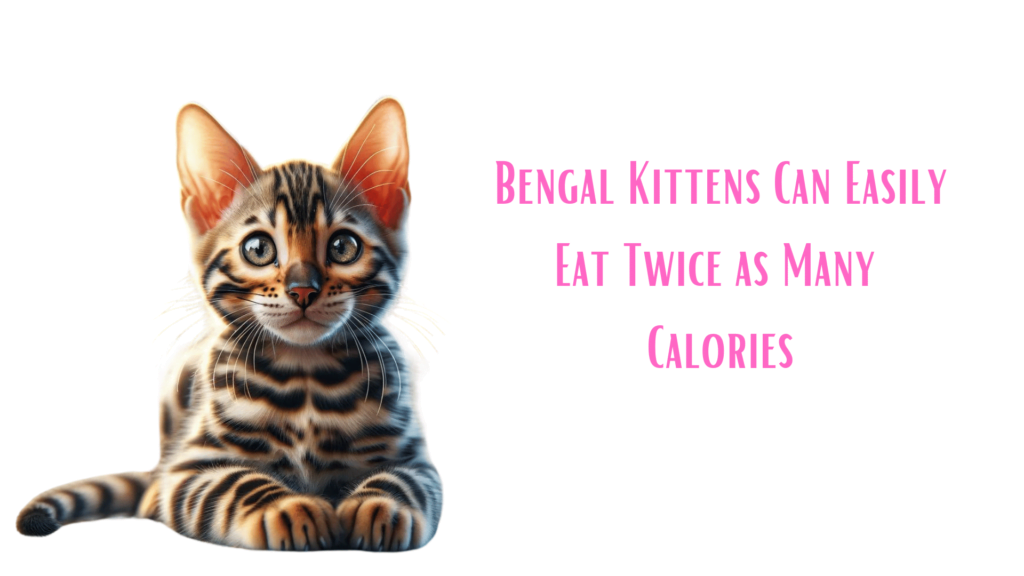
Transitioning to adulthood, Bengals’ caloric needs adjust as their growth slows down. An adult Bengal cat, active and muscular, typically requires around usually needs around 25-30 calories per pound of their body weight per day (depending on activity).
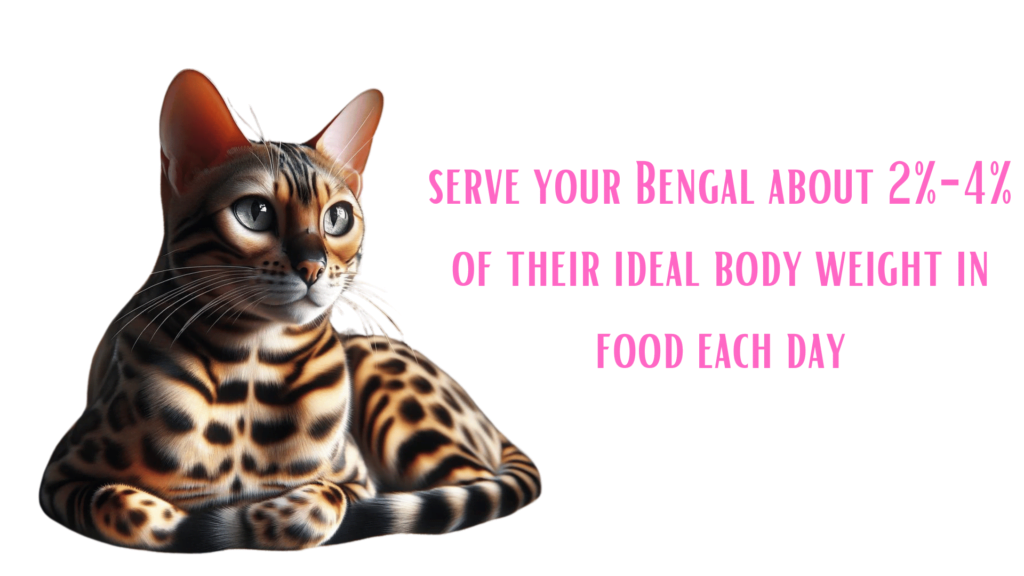
Females typically weigh between 8 to 13 lbs, while males can range from 10 to 15 lbs. These ideal weight ranges are important markers for ensuring your Bengal maintains its agility and health. Regular weigh-ins can help catch any deviation early, allowing for dietary adjustments to keep them in top form.
The lifespan of Bengal cats, typically ranging from 12 to 16 years, can be significantly influenced by their diet. A balanced, nutritious diet, combined with genetics and a loving environment, plays a vital role in how long and how well they live.
Bengal Cats Digestive Sensitivities: Bengals have a shorter intestine, making their stomachs a tad more delicate. It doesn’t take much to upset their digestive balance, potentially leading to the notorious Bengal diarrhea.
Keeping Up with a Bengal: Exercise and Mental Stimulation
When it comes to staying active, Bengal cats take the gold medal. Unlike their more sedentary feline counterparts who might find 30 minutes of daily play sufficient, Bengals see this as just the starting line.
For these energetic felines, the absolute minimum is 60 minutes, but realistically, they thrive on 1-2 hours of physical activity each day. This high level of required exercise is a testament to their athletic nature and boundless energy, setting them far apart from the average house cat.”
Top Exercises for Bengal Cats
1. Cat Wheels
Bengals are one of those breeds for whom cat wheels are highly necessary, not just for fun but also for their energy. Cat wheels allow Bengals to sprint to their heart’s content, mimicking the freedom and speed of outdoor runs while staying safe indoors.
We strongly recommend investing in a robust Cat Wheel, built to withstand the spirited sprints and boundless energy of Bengals.
2. Leash Walking
Bengals often take to leash training with enthusiasm. Walking a Bengal on a leash not only satisfies their curiosity and need for exploration but also provides excellent physical exercise. Here’s a step-by-step guide on how can you take your Bengal on a leash walk.
3. Interactive Toys
Toys that move unpredictably, like laser pointers and feather wands, engage Bengals’ hunting instincts, offering both mental and physical stimulation. Puzzle feeders and treat-dispensing toys also keep them busy, challenging their intellect while rewarding their effort.
The Art of Grooming: Maintaining a Bengal’s Coat
When it comes to grooming, Bengals are somewhat of an anomaly in the feline world. Their coats, while luxurious, don’t demand the high maintenance one might expect.
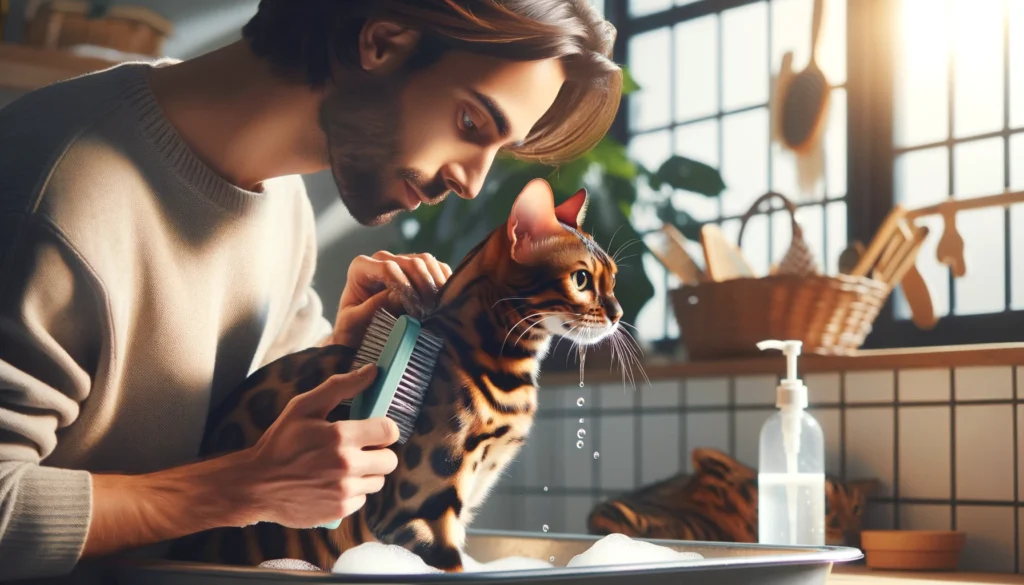
Grooming a Bengal cat is straightforward, especially when compared to high-maintenance breeds (in grooming) like Persians. Here’s what you need for a happy, healthy Bengal.
- Brushing: Less frequent than for long-haired breeds, but essential for keeping their coat shiny. it is generally recommended to brush them weekly.
- Washing: Bengals require fewer baths, maintaining cleanliness with minimal fuss.
- Ear and Eye Cleaning: Regular checks to prevent buildup are enough to keep them clear.
- Nail Clipping: Keeps their active paws in perfect shape.
- Oral Hygiene: Vital for overall health, just like any cat.
| Grooming Activity | Frequency |
|---|---|
| Brushing | Weekly |
| Washing | As needed |
| Ear and Eye Cleaning | Weekly |
| Nail Clipping | Every 4-6 weeks |
| Oral Hygiene | Ideally Daily brushing; professional cleaning as advised by vet |
Training and Education: Harnessing the Bengal’s Intelligence
Bengals are the brainiacs of the cat world, and their capacity for learning might just surprise you. With intelligence that rivals their canine counterparts, these felines are more than capable of mastering an impressive array of tricks and commands. From fetching to high-fiving, their agility and smarts make for some seriously entertaining training sessions.
But it’s not all about the tricks. Mental engagement is key for a breed as intelligent as the Bengal. Interactive play sessions as (mentioned earlier) that stimulate their hunter instincts can turn even a simple game of chase into a brain-boosting workout.
The Perfect Environment: Setting Up Your Home
These mini leopards thrive in indoor spaces that mimic the complexity and richness of the wild landscapes they resemble. Think vertical spaces for climbing, hiding spots for scheming, and a plethora of toys that encourage them to leap, chase, and pounce.
While the great outdoors may call to their wild side, the reality is that the world outside is fraught with risks for a Bengal. From the dangers posed by traffic to the threats to local wildlife, keeping your Bengal indoors or in a secure outdoor enclosure is not just a matter of safety—it’s a matter of responsibility.
Creating the right environment indoors for your Bengal can significantly reduce the chances of them developing unconventional or destructive habits, like excessive scratching on furniture.
Bengal Cat Prices: What to Expect
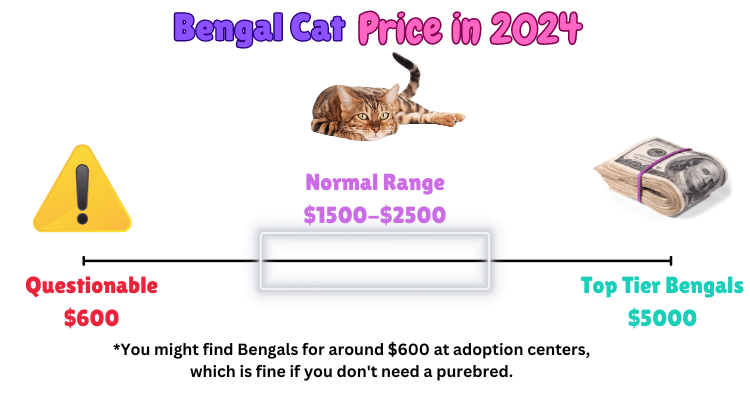
When considering adding a Bengal cat to your family, it’s important to understand the costs involved. The price of a Bengal cat typically ranges between $1500 and $2500, with some rare cases reaching up to $5000.
These stunning felines are usually purchased from specialty breeders, as finding a purebred Bengal in adoption centers or shelters is uncommon. If you do come across a Bengal in a rescue, it’s likely not a purebred, which we cat lovers have no issues with, but it’s something to be aware of. The initial cost might seem high, but it reflects the rarity, selective breeding, and popularity of the breed.
Conclusion: Embracing the Miniature Leopard Lifestyle
These miniature leopards bring a touch of the wild into our homes, along with a hearty dose of affection and antics. While Bengals may require less grooming effort, don’t be fooled—when it comes to energy, they’re high maintenance but in the most entertaining way. Their vibrant personalities and need for engagement make every day an adventure filled with new discoveries.
If you’re considering adding a Bengal to your family, remember the importance of responsible adoption and breeding practices. Seeking out shelters or reputable breeders who prioritize health, temperament, and the well-being of their cats is crucial. It’s not just about finding a pet; it’s about welcoming a new family member into your life.
Meet Sean, a fintech whiz with a penchant for pet purrs and blockchain buzz. After a decade of fintech feats, Sean’s tech talents leaped from ledger lines to litter lines, driven by a passion for pets and a vision for a more connected pet care community. With three critter companions as co-pilots, Sean launched this blog to share a treasury of pet-friendly tech tips and tales.

